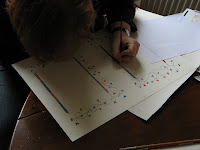So, we've been playing with paint and gesso for about a year now, taking very small steps... Bertrik mostly mixes stuff, and makes test pieces, and I make illuminations to use up the stuff that works.
Projects
At the moment we are working toward two goals: three small illuminated pieces on real parchment as a test of different paints and gesso's and an illuminated book of Polderslot history. This last is a project started 12 years ago (!) and never finished. We are now nearing the Shire's 20th birthday, and thought that would be a good occasion to pick it up again (you'll notice that what was an overly ambitious project to begin with has now more than doubled in size, adding 12 more years to the original 8 or 9 but we're optimistic :))...
Along the way, scroll blanks and small bits of illumination appear as practice pieces and for variation.
Paint
For the paint right now we are using all gum arabic as a binder, since that turned out to be easiest to work with. We mix up a batch and put it in a mussel shell, which is a very convenient container to store it in. It can be re-used just as storebought water colors can by adding water. We tested a little imitation vermillion red paint made with gum arabic on parchment, and it flaked off almost completely. This might be due to the fact that this was unpumiced parchment, but we are a little worried. Along with the gesso experiments, we'll need to experiment with paint binders as well...
Gesso
For the gesso (the ground to apply gold leaf to) we are testing out two recipes, both of which we've almost got working...
Recipe from The Calligrapher's Handbook by Heather Child
16 parts slaked dental grade plaster
6 parts white lead or titanium white (not period but safe, so we're using that)
2 parts sugar; in the last batch we used 4 parts, ground rock candy)
1 part fish glue
a little pigment to see the form; we used 2 parts armenian bole
distilled water (we used 7 parts, which made it quite fluid).
All this needs to be mixed and ground together very well. Then it needs to dry. After it has dried completely once, you can take a little lump, let it sit in a bit of water (just covered), stir it, and use it.
We had some problems with the first batch we made (didn't stick at all and had lumps), so in this batch we used some more sugar and we ground the ingredients much more dilligently than before. The second batch is now drying out, so next week we'll be able to test it.
The other gesso recipe we turned to when the first batch wasn't working. We found it on Randy Asplund's site:
http://www.randyasplund.com/browse/tournpg/tipg.1.htmlThis gesso is quicker than the first recipe, and you can use it right away (no drying step in between).
The trouble we've had with this recipe is that it turns lumpy as soon as it cools down, because the base is hide glue, which is gelatin like, and sets at room temperature. Also, we're clearly too lazy when it comes to grinding, because the first batch of this also had little rocks in it. Now, we've got the gesso in a mussel shell sitting in hot water on a scented oil burner, we've ground it better, and put more water in, so we can make thinner, less blobby layers, and it seems to work better.
So, progress is very slow, but it's there! From now on, I'll try to keep notes of what we do on here, since we just realized during our last visit/advice session with Mistress Oriane that we had almost no record of what we did, which didn't help in trying to work out what we might change to improve things...














